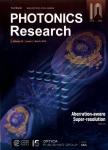Emission spectroscopy of NaYF_(4):Eu nanorods optically trapped by Fresnel lens fibers
Emission spectroscopy of NaYF4:Eu nanorods optically trapped by Fresnel lens fibers作者机构:Universite Grenoble AlpesCNRSInstitut Neel38000 GrenobleFrance 4th Physics Institute and Research Center SCoPEUniversity of Stuttgart70569 StuttgartGermany Universite Paris SaclayCNRSLaboratoire de Physique de la Matiere CondenseeEcole Polytechnique91128 PalaiseauFrance Institute of Applied Optics and Research Center SCoPEUniversity of Stuttgart70569 StuttgartGermany Okinawa Institute of Science and Technology Graduate UniversityOkinawa 904-0495Japan
出 版 物:《Photonics Research》 (光子学研究(英文版))
年 卷 期:2022年第10卷第2期
页 面:332-339页
核心收录:
学科分类:0808[工学-电气工程] 070207[理学-光学] 0809[工学-电子科学与技术(可授工学、理学学位)] 07[理学] 0805[工学-材料科学与工程(可授工学、理学学位)] 0702[理学-物理学]
基 金:Agence Nationale de la Recherche (ANR-16-CE24-0014-01) Okinawa Institute of Science and Technology Graduate University Baden-Württemberg Stiftung (Operial) Bundesministerium für Bildung und Forschung (Printoptics) European Research Council (POC3DPrinted Optics)
摘 要:NaYF_(4):Eu nanorods with high aspect ratios are elaborated and optically trapped using dual fiber optical tweezers in a counterpropagating geometry. High trapping efficiency is observed using converging beams, emitted from diffractive Fresnel lenses directly 3D printed onto cleaved fiber facets. Stable nanorod trapping and alignment are reported for a fiber-to-fiber distance of 200 μm and light powers down to 10 m W. Trapping of nanorod clusters containing one to three nanorods and the coupling of nanorod motion in both axial and transverse directions are considered and discussed. The europium emission is studied by polarization-resolved spectroscopy with particular emphasis on the magnetic and electric dipole transitions. The respective σ and π orientations of the different emission lines are determined. The angles with respect to the nanorod axes of the corresponding magnetic and electric dipoles are calculated. Mono-exponential emission decay with decay time of 4–5 ms is reported. It is shown that the nanorod orientation can be determined by purely spectroscopic means.



